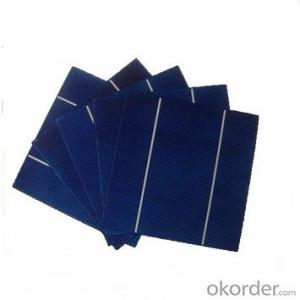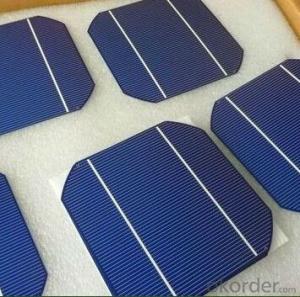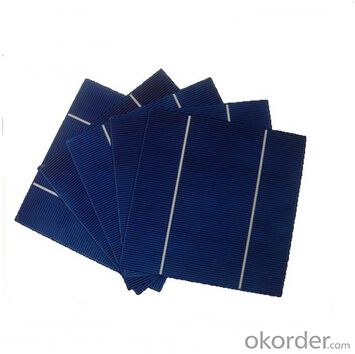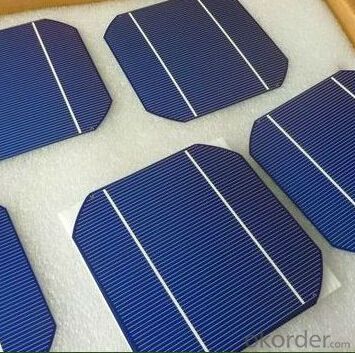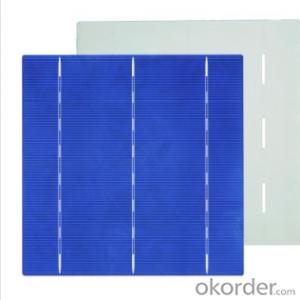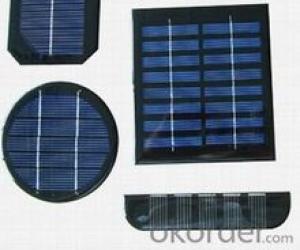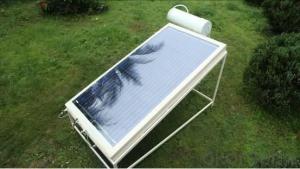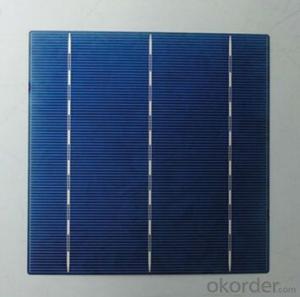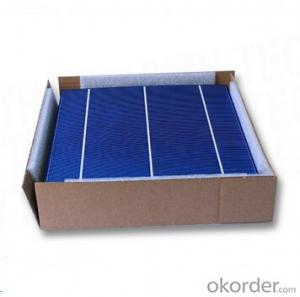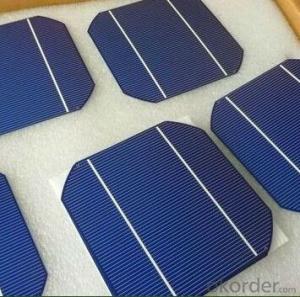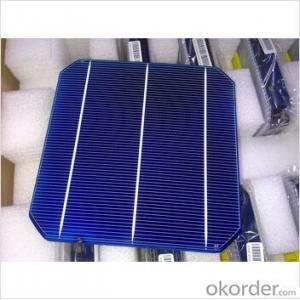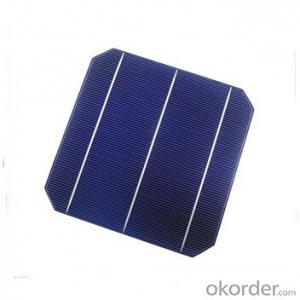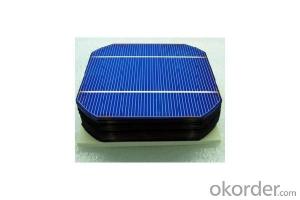Silicon Heterojunction Solar Cells - High Quality Monocrystalline 17.20-18.40
- Loading Port:
- Shanghai
- Payment Terms:
- TT OR LC
- Min Order Qty:
- 1000 pc
- Supply Capability:
- 1000000 pc/month
OKorder Service Pledge
OKorder Financial Service
You Might Also Like
Solar Cells:
Solar cells is made by solar wafer, it has three categories of solar cell right now, monocrystalline polycrystalline and thin film,These cells are entirely based around the concept PN junction, which is the critical part of solar module, it is the part that can convert the light energy into electricity, the thickness is from 180um to 200um, with even busbars to conduct electricity, textured cell can decrease diffuse reflection; they are often electrically connected and encapsulated as a module. Photovoltaic modules often have a sheet of glass on the front (sun up) side, allowing light to pass while protecting semiconductor wafers from abrasion and impact due to wind-driven debris, rain, hail, etc. Solar cells are also usually connected in series in modules, creating an additive voltage. Connecting cells in parallel will yield a higher current;With high quality and stable quality. Our Cells can greatly improve the performance of Solar Modules.
Features:
1. High conversion efficiencies resulting in superior power output performance.
2. Outstanding power output even in low light or high temperature conditions
3. Optimized design for ease of soldering and lamination
4. Long-term stability, reliability and performance
5. Low breakage rate
6. Color uniformity
Solar Cells Advantage:
• High efficiency and stable performance in photovoltaic conversion.
• Advanced diffusion technique ensuring the homogeneity of energy conversion efficiency of the cell.
• Advanced PECVD film forming, providing a dark blue silicon nitride anti-reflection film of homogenous color and attractive appearance.
• High quality metal paste for back surface and electrode, ensuring good conductivity, high pulling strength and ease of soldering.
• High precision patterning using screen printing, ensuring accurate busbar location for ease with automatic soldering a laser cutting.
Specifications:
Efficiency | Efficiency | Pmax(W) | Average | Impp(A) | Vmpp(V) | Isc(A) | Voc(V) |
1840 | 18.30-18.50 | >4.371 | >4.371 | 8.285 | 0.530 | 8.695 | 0.626 |
1820 | 18.10-18.30 | 4.323-4.371 | 4.347 | 8.245 | 0.528 | 8.662 | 0.626 |
1800 | 17.90-18.10 | 4.276-4.323 | 4.299 | 8.190 | 0.526 | 8.630 | 0.625 |
1780 | 17.70-17.90 | 4.228-4.276 | 4.252 | 8.140 | 0.524 | 8.621 | 0.624 |
1760 | 17.50-17.70 | 4.180-4.228 | 4.204 | 8.095 | 0.522 | 8.598 | 0.623 |
1740 | 17.30-17.50 | 4.132-4.180 | 4.156 | 8.045 | 0.520 | 8.568 | 0.622 |
1720 | 17.10-17.30 | 4.085-4.132 | 4.108 | 7.905 | 0.518 | 8.528 | 0.620 |
Packaging & Delivery of Solar Cells
Carton Box Package and Deliver by air. It should be noticed that it should be avoid of water, sunshine and moist.
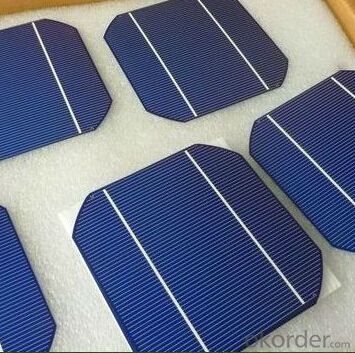
FAQ
We have organized several common questions for our clients,may help you sincerely:
①What price for each watt?
It depends on the efficiency of the solar cell, quantity, delivery date and payment terms.
②How long can we receive the product after purchase?
In the purchase of product within three working days, We will arrange the factory delivery as soon as possible. The pecific time of receiving is related to the state and position of customers.Commonly 7 to 10 working days can be served.
③Can you provide the peripheral products of the solar panels, such as the battery, controller, and inverter? If so, can you tell me how do they match each other?
Yes, we can, we have two companies for solar region, one is CNBM International, the other is CNBM engineering Co.
We can provide you not only the solar module but also the off grid solar system, we can also provide you service with on grid plant.
④What is your warranty of solar cell?
Our product can promise lower than 0.3% open box crack, we support claim after opening the box if it has crackm color difference or sth, the buyer should give pictures immediately, we can not accept the claim after the solar cell has assembled to solar panel.
• Timeliness of delivery
• ⑤How do you pack your products?
We have rich experience on how to pack the solar cell to make sure the safety on shipment, we could use wooden box or pallet as buyer's preference.
- Q: What is the impact of fire hazards on solar cells?
- Fire hazards can have a significant negative impact on solar cells. High temperatures caused by fires can damage or melt the delicate components of solar cells, leading to a decrease in their efficiency or complete malfunction. Additionally, smoke and debris from fires can cover the surface of solar panels, reducing their ability to absorb sunlight and generate electricity. Therefore, fire hazards pose a serious risk to the functionality and longevity of solar cells.
- Q: How big are solar cells?
- Solar cells vary in size depending on their intended use and technology. Traditional silicon-based solar cells typically range in size from a few square centimeters to around 200 square centimeters. However, advancements in solar technology have led to the development of smaller, more efficient solar cells, known as thin-film solar cells, which can be as small as a few square millimeters. Additionally, solar cells can be grouped together to form larger arrays, which are commonly used in residential, commercial, and utility-scale solar installations.
- Q: What is the maximum efficiency possible for a solar cell?
- The maximum efficiency possible for a solar cell, based on current technology, is around 44%.
- Q: Can solar cells be used for battery charging?
- Yes, solar cells can be used for battery charging. Solar cells convert sunlight into electricity, which can be used to charge batteries. This process is commonly used in solar-powered devices and systems to harness renewable energy and store it in batteries for later use.
- Q: Can solar cells be used for powering electric vehicle charging stations with battery storage?
- Yes, solar cells can be used to power electric vehicle charging stations with battery storage. Solar cells convert sunlight into electricity, which can be used to charge electric vehicle batteries directly or stored in batteries for later use. This allows for a cleaner and sustainable way to power electric vehicle charging stations, reducing dependence on fossil fuels.
- Q: What is the lifespan of a solar cell?
- The lifespan of a solar cell can vary depending on various factors such as the quality of the materials used, the manufacturing process, and the operating conditions. On average, most solar cells have a lifespan of around 25 to 30 years. However, with proper maintenance and care, some solar cells can continue to produce electricity for even longer periods.
- Q: How do solar cells impact job creation?
- Solar cells have a positive impact on job creation as they require a skilled workforce for the manufacturing, installation, and maintenance of solar panels. The growing demand for solar energy has created various job opportunities in sectors such as engineering, construction, and clean energy technology, thus contributing to economic growth and employment opportunities.
- Q: Can solar cells be used in shopping malls?
- Yes, solar cells can be used in shopping malls. In fact, many shopping malls around the world have already adopted solar panel systems to generate clean and renewable energy. These solar cells can be installed on rooftops, parking lots, or even as shading structures in outdoor areas, helping to reduce electricity costs and environmental impact.
- Q: How does solar cell technology apply to our daily life?
- Solar cells are used to make solar modules which generate electrical power from sunlight,
- Q: Can solar cells be used for powering satellites?
- Yes, solar cells can be used for powering satellites. In fact, they are the primary source of power for most satellites in space. Solar cells convert sunlight into electricity, which is stored in batteries for use during periods of darkness or when the satellite is in Earth's shadow.
Send your message to us
Silicon Heterojunction Solar Cells - High Quality Monocrystalline 17.20-18.40
- Loading Port:
- Shanghai
- Payment Terms:
- TT OR LC
- Min Order Qty:
- 1000 pc
- Supply Capability:
- 1000000 pc/month
OKorder Service Pledge
OKorder Financial Service
Similar products
Hot products
Hot Searches
Related keywords
